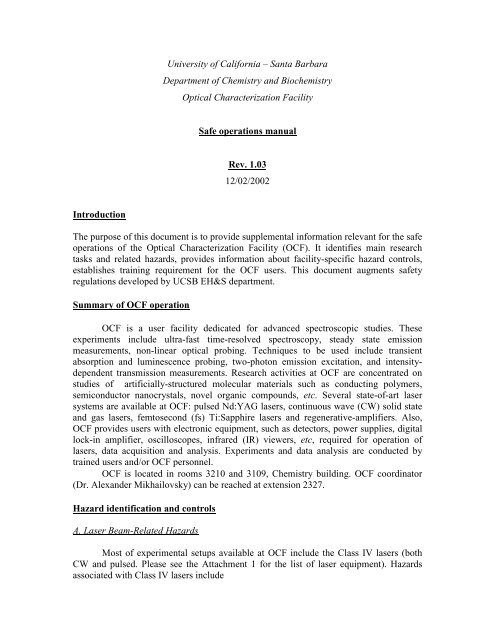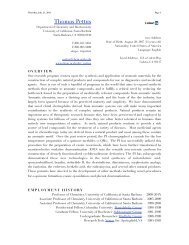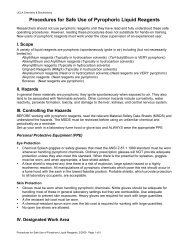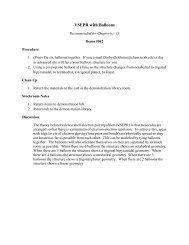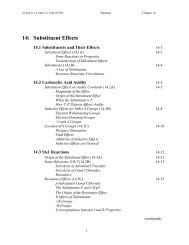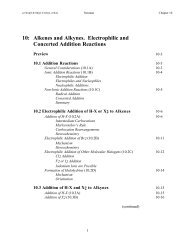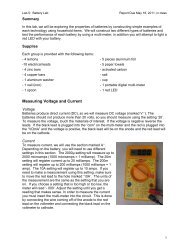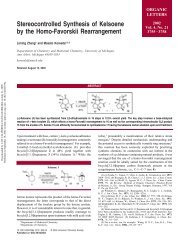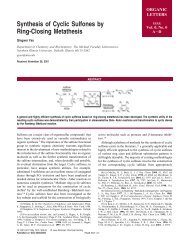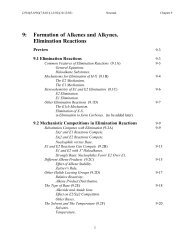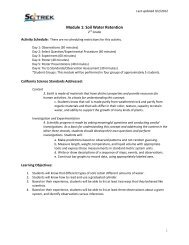University of California - Department of Chemistry and Biochemistry ...
University of California - Department of Chemistry and Biochemistry ...
University of California - Department of Chemistry and Biochemistry ...
Create successful ePaper yourself
Turn your PDF publications into a flip-book with our unique Google optimized e-Paper software.
RenhållningsföreskrifterförSträngnäs kommunFöreskrifter om avfallshantering2013Antagna av kommunfullmäktige 2013-06-17, § 78
2. All lasers have interlocked covers <strong>and</strong> enclosures. Interlocks should be checkedon the regular basis by the OCF staff <strong>and</strong> maintained in the working condition.3. Beams <strong>of</strong> the CW pump lasers (Evolution X <strong>and</strong> Millennia) are enclosed intobeam tubes. This protection should never be removed by the OCF users.Installation <strong>of</strong> additional beam enclosures by users is not m<strong>and</strong>atory butrecommended.4. Laser operators are protected from the reflected <strong>and</strong>/or scattered laser beams byscreens <strong>and</strong> curtains. During experiments or alignment, laser curtains should beclosed (though black out curtains may be kept open). Portable metal screensshould be used to block stray reflections from the optical components.Administrative controls.1. Warning lights are installed or placards are posted at the OCF entrances to informvisitors, users, <strong>and</strong> staff members about the lasers status. If a Class IV laser is on,only OCF personnel, authorized users, <strong>and</strong> escorted visitors are allowed to enter.2. Users must receive appropriate safety training. Level <strong>of</strong> the training depends onlevel <strong>of</strong> involvement in the OCF operations.a. Occasional userOccasional users can use OCF lasers only under supervision <strong>of</strong> the OCFpersonnel. Required training:• UCSB laser safety manual• OCF safe operations manualb. Permanent userPermanent users can use OCF laser equipment without direct supervision <strong>of</strong>the OCF staff. Required training:• UCSB laser safety manual• OCF safe operations manual• Laser operation manual (for the laser(s) used)• UCSB laser safety video (available at EH&S)• UCSB laser safety training (if available)• Interview with the OCF coordinatorUsers must keep track <strong>of</strong> their safety training in the user logbook.3. All activities involving use <strong>of</strong> lasers must be supervised by the OCF staff. Evenpermanent user must consult OCF coordinator before starting a new project orexperiment, in order to evaluate hazards <strong>and</strong> develop appropriate controls. OCFstaff members have a right to ban users from work, if the safety is compromised.All activities must be recorded in the logbook, major changes in optical setupsmust be approved by the OCF staff.4. Users must implement safe work practices. Users, P.I.s, <strong>and</strong> OCF staff membersare equally responsible for the workplace safety.
• Before doing the work, hazards analysis must be performed <strong>and</strong> appropriatecontrols developed.• During the scope <strong>of</strong> the work, users must check regularly for unaccountedhazards (e.g., beam reflections, unblocked beams) <strong>and</strong> eliminate thempromptly.• After completion <strong>of</strong> the work, additional hazard analysis may be performed inorder to provide a feedback for future experiments.• Users must inform OCF personnel <strong>and</strong> other users about real <strong>and</strong> possibleproblems promptly. Experience sharing is strongly encouraged.5. Additional safety rules• All reflective objects (e.g., rings, badges, watches) must be taken <strong>of</strong>f beforeperforming any work involving lasers. OCF personnel is not responsible fortheft or loss <strong>of</strong> these items.• Laser beam must be blocked by an appropriate beam dump when any opticalcomponent is replaced or added or the laser beam is not used.• Bending or leaning on the optical table is prohibited. Users shall avoid placingeyes at the beam level. Stepstools or ladders should be used to reach remoteareas <strong>of</strong> the optical table.• If necessary, OCF personnel may impose two-persons rule on any operation.• If not being used for more than 2 hours, lasers must be interlocked byremoving safety keys from locks on the power supplies.Personal Protection Equipment (PPE)Laser safety eyewear for all OCF lasers is available to users. Eyewear used must becompatible with laser emission wavelength (See Attachment 2 for the laser gogglescompatibility chart). Users must be aware that laser safety glasses are for diffuse lightviewing only. Direct exposure must be avoided by all means.Laser safety glasses must be worn by users all the time, unless the beams arecontained or blocked completely (for example, laser protection curtain in rm 3210blocks laser emission completely when closed).Laser Alignment ProceduresLaser alignment involves additional hazards, since probability <strong>of</strong> exposure to the laserradiation increases greatly. The following rules must be observed during the laseralignment:• Two-persons rule must be observed, if the major alignment is performed by anOCF user.• All other activities are prohibited in the same room, unless appropriateprotection is provided.• Only essential personnel are allowed in the work area. Warning signs shouldbe placed near the OCF entrances.
B. Electrical HazardsThere are no facility specific electrical hazards. Users are not allowed to perform anyelectrical work on the OCF equipment. All OCF instruments are UL-listed <strong>and</strong> meetnational safety st<strong>and</strong>ards. Users must follow electrical safety regulations adopted byUCSB.C. Chemical HazardsNo chemical work is allowed in OCF. However, exposure to solvents is still possibleduring samples h<strong>and</strong>ling. PPE (gloves, lab coats, safety goggles) is required forsamples h<strong>and</strong>ling. St<strong>and</strong>ard safety procedures must be followed.D. Cryogenic HazardsCryogenic liquids (LN 2 <strong>and</strong> LHe) can be used for cooling cryostats. Only smallamounts <strong>of</strong> liquefied gases (less than 2 gallons) are allowed in OCF. PPE (insulatinggloves, safety goggles, aprons, etc) are required for h<strong>and</strong>ling cryogenic liquids.Safety Accidents <strong>and</strong> Near-Accidents• All accidents <strong>and</strong> near-accidents must be reported to OCF staff <strong>and</strong><strong>Department</strong> management immediately.• In case <strong>of</strong> accident or near-accident, all activities in OCF must be terminatedimmediately. Restart <strong>of</strong> the work is authorized by the OCF coordinator <strong>and</strong>/or<strong>Department</strong> management.• Persons involved in an accident must seek medical assistance. In case <strong>of</strong> lifethreateningsituation, emergency response services must be notified as soon aspossible.• Persons involved in accidents <strong>and</strong> near-accidents, or creating hazardoussituations can be banned from work by the OCF staff <strong>and</strong> <strong>Department</strong>management for any period <strong>of</strong> time (life-time ban is also possible).H<strong>and</strong>ling <strong>of</strong> Emergency Situations• If the evacuation is announced due to fire or poisonous gas alert, users may leavethe lasers on, but the open beams must be blocked by an appropriate beam dumps.
Attachment 1.List <strong>of</strong> the lasers available at OCF1. Spectra- physics Millenia-V: 5 Watts (cw), 532 nm, Class IV2. Spectra-physics Evolution-X: 10 mJ, 527 nm, 150 nsec (pulse width), 1kHz(PRF), Class IV3. Spectra-physics Tsunami: 10 nJ, 650-1000 nm, 90 fsec (pulse width), 80 MHz(PRF), Class IV.4. Spectra-physics Spitfire: 1 mJ, 740-900 nm, 90 fsec (pulse width), 1 kHz (PRF),Class IV.5. Spectra-physics BeamLock 2060, 3 Watts (cw), 351,363, 457,476, 488, 496, 514nm, Class IV.6. QuantaRay DCR-11, 400 mJ, 1064, 532, 266 nm, 20 nsec (pulse width), 10 Hz(PRF), Class IV7. Spectra-physics 3900S, 1 Watt (cw), 690-1000m, Class IV
Attachment 2Laser safety goggles compatibility chartLaser Emission wavelength Type <strong>of</strong> safety glassesMillenia-V 532 nm LSK-Argon/KTPEvolution X 534 nm LSK-Argon/KTPSpitfire 750-900 nm LPA-ALEXTsunami 700-1000 nm LPA-ALEXModel 3900 700-1000 nm LPA-ALEXQuantaRay 1064/532/266 nm Bolle Laser Z87Beamlock 350-514 nm LSK-Argon/KTP


